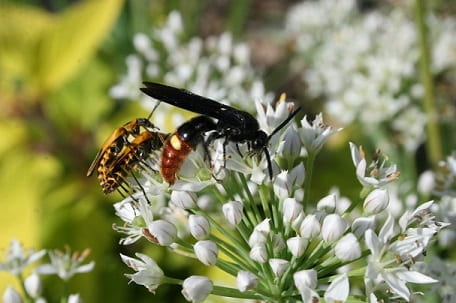–by Dr. Raymond Cloyd
We continue to see large “wasps” (not cicada killer wasps) feeding on flowering plants such as goldenrod (Solidago spp.) and wild onion (Allium spp.). This is Scolia dubia, which is a parasitoid of green June beetle (Cotinis nitida) larvae or grubs located in the soil. Since there were so many green June beetle adults flying around this year, there is likely to be high populations of grubs/larvae for the parasitoids to attack.
The parasitoids are approximately 3/4-inches long with purple to black wings. The abdomen has red-brown markings with two conspicuous yellow spots on both sides of the third abdominal segment (Figure 1).
Fig 1. Scolia dubia adult feeding on flower (Auth–Raymond Cloyd, KSU)
The parasitoids can be observed flying in a figure-eight pattern several inches above turfgrass infested with green June beetle larvae. A female enters the burrow of a green June beetle larva, uses her ovipositor (egg-laying device) to paralyze the larva, and then she attaches an egg to the underside of the larva. The larva hatches from an egg and consumes the paralyzed green June beetle larva. The larva overwinters in a cocoon at the bottom of the burrow and then pupates in the spring. Adult parasitoids typically emerge from August through September, and feed on flower nectar. They are likely emerging and present later than usual due to the weather conditions we have experienced this year (lots of rain and cool temperatures). Scolia dubia adults, unlike cicada killer males, are not aggressive and females will only sting when handled.
